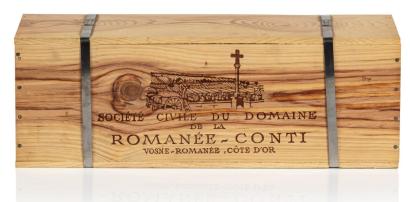
DRC has added to its repertoire with vines in the Grand Cru of Corton leased from the estate of Prince Florent de Mérode, the first vintage release being 2009. In some years, a wine created out of a blend of declassified Vosne Grands Crus is released as Cuvée Duvault-Blochet, named after a 19th century owner of the estate. And a tiny plot within Vosne-Romanée Petits Monts (premier cru) that was blended into Duvault-Blochet has been bottled separately since 2018, the label sold exclusively to selected French restaurants.
In addition to the white Le Montrachet, where 3000-4000 bottles are made annually, the Domaine owns a small parcel of neighbouring Bâtard-Montrachet, sufficient for only two barrels (600 bottles) none of which is released for commercial sale. Recently a form of co-production was announced with Domaine Bonneau du Martray to produce a Corton-Charlemagne, with the 2019 vintage being DRC's first official release. Very occasionally, a Bourgogne, Hautes-Côtes de Nuits Blanc is seen on the market, plainly and inconspicuously labelled, but quietly vinified by the Domaine. This comes from vines close to the ruins of the Abbaye de Saint-Vivant de Vergy, a one-time owner of DRC’s Romanée-St-Vivant vines – an historical landmark currently being restored under the supervision of Aubert de Villaine, whose family are co-owners of the Domaine alongside the two daughters of the late négoçiant Henri Leroy, 'Lalou' Bize-Leroy and Pauline Roch. (Current co-directors of the Domaine are Bize-Leroy's daughter Perrine Fenal and de Villaine's son Betrand de Villaine).
DRC’s global repute rests squarely on its wines, particularly Romanée-Conti, La Tâche and Richebourg. It is not just the viticulture – small yields, organic and now biodynamic cultivation and the late harvesting of perfectly-ripe grapes - and meticulous winemaking that account for the supremacy of the wines. Like Pétrus in Pomerol, these great vineyards sit on incomparable soils. A visit to the site one summer recently just after light green harvesting had taken place permitted a taste of its grapes from bunches that lay on the ground. Despite their not being fully ripe, the taste was complex and engaging, intensely aromatic and long-lasting – unlike any other grape I had experienced.
Through its appointed country agents the Domaine maintains a high degree of control over the international distribution of its wines, ensuring its scarce production is enjoyed by preferred restaurants and by privileged private clients. Within France, such customers enjoy direct allocations year after year, almost in perpetuity. An active secondary market exists for DRC wines, generally managed by country agents but frequently fed by ‘allocataires’ that find themselves with more bottles than they can feasibly drink. The allocation system ensures first owners buy at official prices; demand pressure ensures that open-market prices are multiples higher. A bottle of a new vintage of Romanée-Conti, for example, will cost a preferred client around £3,000 plus duty & VAT. On the open market the same bottle may change hands at around (or in excess of, in the greatest vintages) £20,000. Such is the premium for scarcity.
DRC wines are targets for counterfeiting, especially large formats from mature vintages. Restaurants are encouraged to destroy empty bottles to prevent illegitimate re-use, and the Domaine applies a number of non-publicised control devices to the labels and capsules to deter this activity. Like most producers, it declines to authenticate individual bottles, relying on its agents to maintain records of the bottles they have sold, via serial numbers and, recently, proof-tags. A small industry has grown around the authentication of these rare wines. Generally, an authenticator can identify counterfeits but is normally unable to warrant a bottle as genuine.
Enquire here about Provinance's availability of wines from this producer.
